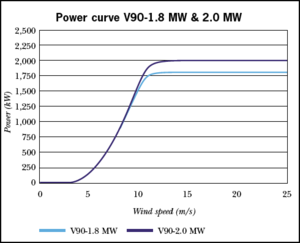Wind turbine: Difference between revisions
No edit summary |
No edit summary |
||
| Line 7: | Line 7: | ||
The nacelle can be turned at the top of the tower to keep the blade assembly perpendicular to the wind and upwind of the rest of the nacelle. And each blade can be rotated on its axis to adjust its pitch, changing the amount of “lift” from the wind that moves it around the hub so that the rotation speed remains fairly constant. | The nacelle can be turned at the top of the tower to keep the blade assembly perpendicular to the wind and upwind of the rest of the nacelle. And each blade can be rotated on its axis to adjust its pitch, changing the amount of “lift” from the wind that moves it around the hub so that the rotation speed remains fairly constant. | ||
Every wind turbine has a range of wind speeds at which it is operational, from the “cut-in” to the “cut-out” speed. When the wind is close to “cut-in” speed, the generator is used as a motor to start the blades turning in anticipation. | [[file:Vestas-V90-power-curve.png|thumb|Power curve (power generated versus wind speed) for two Vestas V90 models. The cut-in speed is 4 m/s (9 mph). The rated speeds are ~11–12 m/s (25–27 mph). The cut-out speed is 25 m/s (56 mph).]] | ||
Every wind turbine has a range of wind speeds at which it is operational, from the “cut-in” to the “cut-out” speed. When the wind is close to “cut-in” speed, the generator is used as a motor to start the blades turning in anticipation. As the wind speed increases, the blades are able to overcome the power flowing in from the grid and begin to push power out. When the model’s “rated” wind speed is reached, the turbine is able to produce at its rated capacity, e.g., a 2-MW turbine is generating power at 2 MW. As the wind speed increases further, the blades are increasingly pitched (rotated on their axis) to capture less of its energy to keep their rotation speed fairly constant. At the cut-out wind speed, the blades are completed “feathered” to stop spinning, and at higher wind speeds they are braked to prevent damage. | |||
The energy in the wind increases eight times for every doubling of the wind speed. | |||
==See also== | ==See also== | ||
Revision as of 00:07, 30 August 2017
Although there are many ways that the wind can be used to turn a turbine, this site concerns the 3-bladed horizontal-axis upwind design that is usually used.
The only major design difference is direct-drive versus gearbox-driven generators. The former used to be primarily used in smaller wind turbines for on-site home and farm use but are increasingly used in larger wind turbines for the advantage of fewer moving parts. The gearbox on wind turbines is a common site of mechanical failure. Direct-drive generators, however, because the rotor speed is slower, require many – up to tenfold – more magnets, about a third of whose composition is the rare earth metal neodymium. Although rare earth metals turned out to be – well after receiving the classification – not all that “rare”, their mining and processing are highly toxic and environmentally harmful, and the supply is therefore limited.[1]
The basic design begins with a steel tubular tower that on land is anchored to a steel bar–reinforced concrete foundation which may be further anchored by drilled pilings. At the top of the tower sits the “nacelle” (named after the engine housing of an aircraft) containing the rotor shaft, gearbox, and generator. At one end of the nacelle, three airfoil blades are connected to a hub that is connected to the rotor shaft.
The nacelle can be turned at the top of the tower to keep the blade assembly perpendicular to the wind and upwind of the rest of the nacelle. And each blade can be rotated on its axis to adjust its pitch, changing the amount of “lift” from the wind that moves it around the hub so that the rotation speed remains fairly constant.
Every wind turbine has a range of wind speeds at which it is operational, from the “cut-in” to the “cut-out” speed. When the wind is close to “cut-in” speed, the generator is used as a motor to start the blades turning in anticipation. As the wind speed increases, the blades are able to overcome the power flowing in from the grid and begin to push power out. When the model’s “rated” wind speed is reached, the turbine is able to produce at its rated capacity, e.g., a 2-MW turbine is generating power at 2 MW. As the wind speed increases further, the blades are increasingly pitched (rotated on their axis) to capture less of its energy to keep their rotation speed fairly constant. At the cut-out wind speed, the blades are completed “feathered” to stop spinning, and at higher wind speeds they are braked to prevent damage.
The energy in the wind increases eight times for every doubling of the wind speed.
